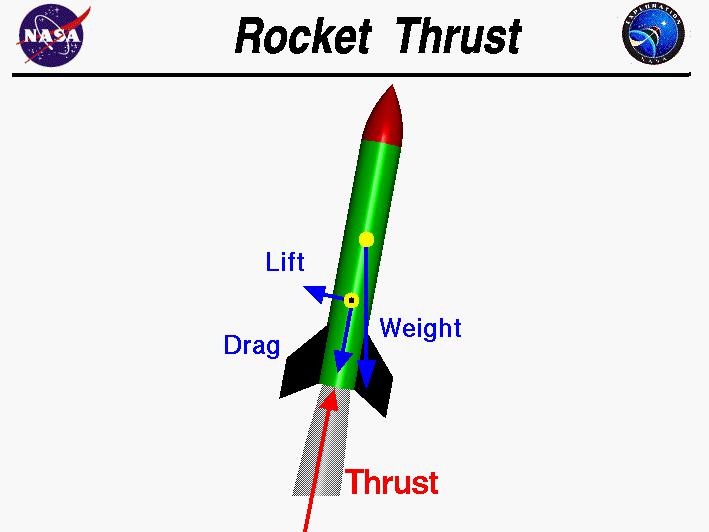Rocket Science – Explanation and What Causes Thrust in The ...
Rocket science is the primary branch of aerospace engineering, which is the science of building, or designing rockets.
All the rockets follow Newton’s three laws of motion.
According to Newton’s first law, a rocket will stay on the launch pad until a force blast it off. Once in space, a rocket will proceed to move unless retrorockets are fired to slow down the rocket.
Newton’s Second Law : Force on a body equals the product of its mass multiplied by acceleration.
F = m * a
So, the main forces acting on a rocket in flight are the weight of the rocket, thrust of the rocket engines, and drag.
Now, as the rocket moves through the air, during its flight, it undergoes a few operations that its weight gets greatly reduced, therefore; it achieves a greater acceleration.
Newton’s Third Law of Motion: This law states that it is necessary to keep the rocket moving so that it ejects a high amount of gas at high speeds.
A rocket can lift off from a launchpad only when it ousts gas at high speeds from its engine. The rocket thrusts against the gas, and the gas, in turn, propels the rocket.
What causes Thrust in the Rocket?
Thrust is a force with which the rocket moves upwards. It is given by,
F = - u dm/dt
In space, rocket engines are ordinarily called reaction engines because the law of reaction crusades the spacecraft to move in a direction opposite to that of the engine’s thrust plume.
The negative sign in the formula indicates that thrust on the rocket is in a direction opposite to the direction of escaping gases.
How does a Rocket Work?
The term rocket science is often used to describe a concept that is quite difficult to comprehend.
Let’s understand the technology behind its working in a simple yet scientific manner.
To eject the high-speed mass from the rocket, a liquid fuel oxidizer mixture is burnt in the rocket combustion chamber, the combustion chamber also helps fuel and oxidizer to mix them efficiently.
[Image will be uploaded soon]
A high-speed jet is passed through a rocket nozzle, the function of the nozzle is to increase the exhaust velocity even further thus increasing the rocket’s thrust.
These types of nozzles are called converging-diverging nozzles.
[Image will be uploaded soon]
So, the subsonic flow gets converted to supersonic flow with the help of such a nozzle.
The liquid fuel before entering the combustion chamber travels around the nozzle body.
[Image will be uploaded soon]
This helps to reduce the nozzle’s cover temperature and also results in some energy savings.
To pump fuel and oxidizer at an adequate flow rate, two pumps are used. They are:
Fuel Pump
Oxidizer Pump
They both are connected with the same shaft.
[Image will be uploaded soon]
The pump-turbine is referred to as a turbopump. A gas generator produces hot gas which will turn the turbine. A bypass jet of fuel and an oxidizer are fed into the gas generator for combustion; exhaust from the turbine is mixed with the main rocket exhaust. This unit of the rocket is called the rocket engine.
[Image will be uploaded soon]
Here, the rocket engine is peculiarly the liquid propellant rocket engine.
The fuel and oxidizer required for rocket engine are started to two large tanks as shown below:

[Image will be uploaded soon]
During the liftoff, the thrust generated by the main engine may not be adequate.
Generally, a few solid propellant strap boosters are used to assist the liftoff.
[Image will be uploaded soon]
Solid propellant strap boosters
[Image will be uploaded soon]
Inner view of the solid propellant rocket
The rocket starts with zero speed at the ground.
However, it must accelerate at the final speed of 28000 Kmph to achieve orbit successfully.
The solid propellant strap boosters are burned off very quickly.
So, to reduce the weight of the rocket, they are abandoned after the burn-off.
This process is known as rocket staging.
[Image will be uploaded soon]
Rocket staging
When the main engine is burned off, it is also abandoned.
[Image will be uploaded soon]
The main engine abandoned
The next engine takes over the charge. In this way, the rocket’s weight is greatly reduced.
So, by the relation: F = m * a
Mass is reduced, therefore, it achieves greater acceleration.
Finally, after a few stages of operation, the payload is put into the desired orbit.
[Image will be uploaded soon]
The rocket staging up to five have been successfully tested.
[Image will be uploaded soon]
Payload set in its orbit
So how is the rocket able to maneuver its destination?
[Image will be uploaded soon]
So, there is a modern car technique named cabled thrust also called the Gimbaled Thrust.
[Image will be uploaded soon]
Diagram: Gimbaled thrust
Here, the rocket nozzle is tilted with high precision devices.
[Image will be uploaded soon]
Diagram: Gimbaled angle
Any deviation in the normal angle will produce a torque which in turn will make the rocket’s body rotate.
[Image will be uploaded soon]
Therefore, after achieving enough turn, the gimbal angle is set to 0.
What Rocket Scientists do?
Rocket scientists are aerospace engineers who are experts in the designing and manufacturing of spacecraft.
They diligently work with the principles of science and engineering to create vehicles that aviate within or above the Earth’s surface.
-
Latest
 How to ask for help from the universe – Suzanne Heyn
How to ask for help from the universe – Suzanne HeynI’ve been living dangerously.Yesterday, the day I normally spend writing my blog, I got a massage. Not just any massage. A 90-minute one. (I’m trying this new thing where I trust that my work is good...
-
Next
 7 Steps to Manifest Anything You Want -- Including Money ...
7 Steps to Manifest Anything You Want -- Including Money ...You know manifesting works for other people, but you feel as though you're missing something to make it work for you.The number one reason most people get stuck while manifesting is they don't know ev...
Popular Articles
- Rocket Power (TV Series 1999–2004) - Rocket Power (TV Series ...
- technique - What is the definition of 'playing in the pocket ...
- "Pocket rockets," in poker Crossword Clue Answers, Crossword ...
- 5 Sex Toys Every Man Should Own, Use & Use Again - LA Weekly
- Pocket Holsters: 11 Options For Easy Everyday Carry (2021 ...
- What is Elton John's most successful song? (Celebrity Exclusive)
